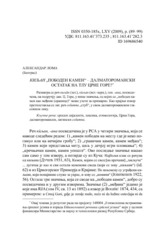Приказ основних података о документу
Kiljan 'Stone stuck into the ground': A dalmato-romance relic in Montenegro?
Киљан „пободен камен“ - далматоромански остатак на тлу Црне Горе?
| dc.creator | Лома, Александар | |
| dc.date.accessioned | 2018-05-19T18:36:34Z | |
| dc.date.available | 2018-05-19T18:36:34Z | |
| dc.date.issued | 2009 | |
| dc.identifier.issn | 0350-185X | |
| dc.identifier.uri | https://dais.sanu.ac.rs/123456789/3191 | |
| dc.description.abstract | The word kiljan / kiljan, -a (Variants: kiljen, kiljaš) is found in the most parts of Montenegro; its area ranges over the border between Zeta - and East-Herzegovina dialects of Serbian. Of its five meanings, three are to be considered peripheral (building block (of limestone) in SW, target in a game in NW), or occasional (hill). The core meaning of the word seem to be 'a stone stuck into the ground', to mark something, either a boundary between the fields or a place of somebody's violent death (shifting to 'gravestone'). Of these two usages, the former may claim the priority, ancient boundary stones being often reinterpreted, in local legends, as memorial ones. Indeed marking the land parcels with stones was unfamiliar to the ancient Slavs (Common Slavic *medja land boundary is usually a hedge, a grove, a path or a furrow), but characteristic of Mediterranean countries with their scarcity of arable land; for the ancient Greeks, it is attested since the Homeric epoch, and was practiced by the Romans too, which suggests a possible Romance source of the word in question. Significantly enough, this practice is attested by the Old Serbian charters only for Zeta, a SW Montenegrian region where kiljan is the proper term for this kind of landmarks (in a charter from 1316, it is not explicitly mentioned, but described by kamy ukopan stone dug into the ground). The word kiljan has no convincing etymology so far Illyrian one proposed by Petar Skok in his etymological dictionary is made up out of thin air, and a possible interpretation based on (Balto)Slavic facts (Lith. kuũlis 'stone', Common Slavic **kyl- as a variant of *kъl- eyetooth tusk; crag') highly improbable as well. However, the Old Dalmatian, a Romance language extinct since the end of 19th century, provides a plausible source with its continuation of the Latin word columna 'column, pillar', which is kilauna; and the SCr forms kelomna / kelovna in Ragusa (Dubrovnik), kilovna in the Bay of Cattaro (Kotor) in today's Montenegro must go back to a similar Romance form. Although the details of vocalism are not clear, especially the development in the penultimate, the derivation kiljan columna seems highly probable in view of the fact that in medieval Latin sources from Dalmatia the same thing - a boundary stone - is designated by colonella, a derivative from Lat. columna. | en |
| dc.description.abstract | Razmatra se reč kiljan (zet), kiljan (ist.-herc), gen. -ana, posvedočena na području dan. C. Gore, u više značenja, od kojih se 'poboden kamen kao međnik (oranice)' može uzeti za primarno. Kao krajnji izvor pretpostavlja se lat. reč columna 'stub', u svom dalmatoromanskom glasovnom liku. | sr |
| dc.relation | info:eu-repo/grantAgreement/MESTD/MPN2006-2010/148004/RS// | |
| dc.rights | openAccess | |
| dc.rights.uri | https://creativecommons.org/licenses/by-nc-nd/4.0/ | |
| dc.source | Јужнословенски филолог | |
| dc.subject | srpski dijalekti | sr |
| dc.subject | leksika | sr |
| dc.subject | etimologija | sr |
| dc.subject | Crna Gora | sr |
| dc.subject | dalmatoromanski | sr |
| dc.subject | latinski columna | sr |
| dc.title | Kiljan 'Stone stuck into the ground': A dalmato-romance relic in Montenegro? | en |
| dc.title | Киљан „пободен камен“ - далматоромански остатак на тлу Црне Горе? | sr |
| dc.type | article | |
| dc.rights.license | BY-NC-ND | |
| dcterms.abstract | Loma, Aleksandar; Kiljan „poboden kamen“ - dalmatoromanski ostatak na tlu Crne Gore?; | |
| dc.citation.spage | 89 | |
| dc.citation.epage | 99 | |
| dc.citation.issue | 65 | |
| dc.identifier.doi | 10.2298/JFI0965089L | |
| dc.type.version | publishedVersion | |
| dc.identifier.fulltext | https://dais.sanu.ac.rs/bitstream/id/20927/3269.pdf | |
| dc.citation.other | (65): 89-99 | |
| dc.identifier.rcub | https://hdl.handle.net/21.15107/rcub_dais_3191 |
Документи
Овај документ се појављује у следећим колекцијама
-
Јужнословенски филолог / Južnoslovenski filolog
ISSN 0350-185X; eISSN 2406-0763

